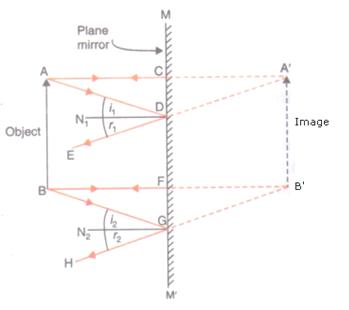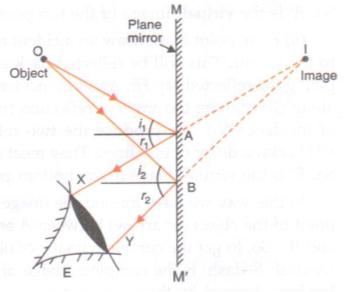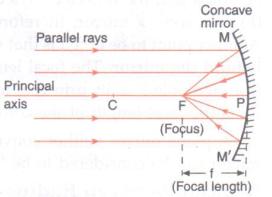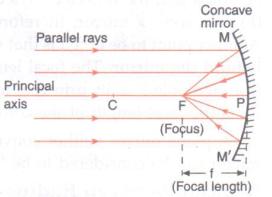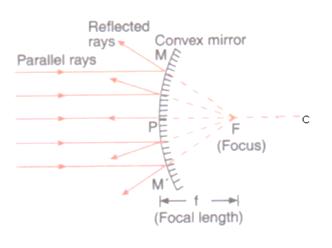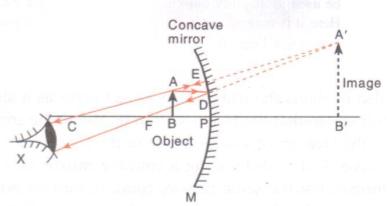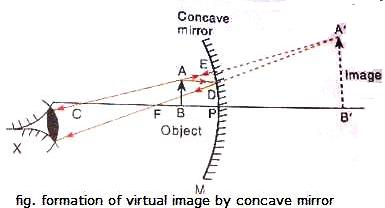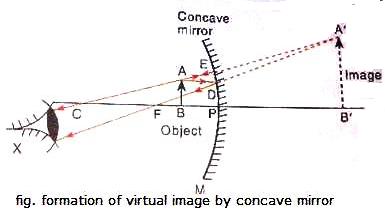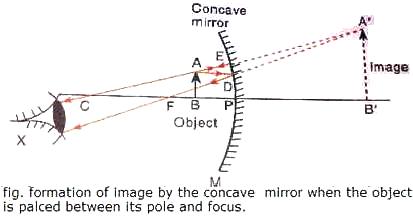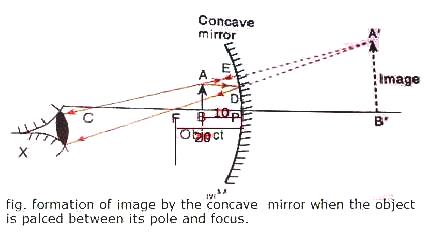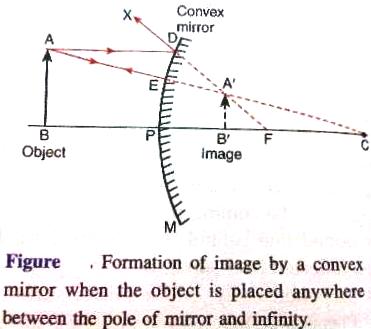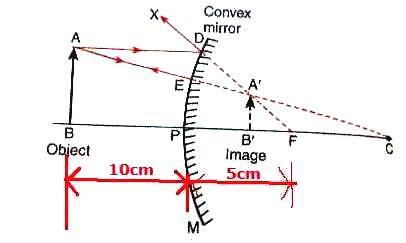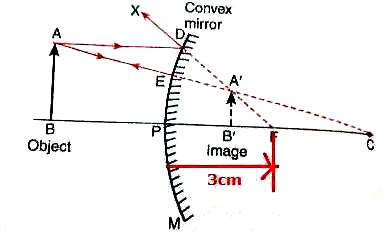Class 10 LAKHMIR SINGH AND MANJIT KAUR Solutions Physics Chapter 4 - Reflection of Light
Reflection of Light Exercise 173
Solution 1
As ray of light falls normally on mirror, this means that angle of incidence is 0o. From second law of reflection, we know that angle of incidence is equal to angle of reflection. So, angle of reflection will also be zero. Therefore, the light ray will be reflected back along the same path.
Solution 2
According to the second law of reflection, angle of incidence is equal to the angle of reflection.
Therefore, angle of reflection=300
Solution 3
Angle to the mirror surface=400
Therefore, angle of incidence= 900-400=500
According to the second law of reflection, angle of incidence is equal to the angle of reflection.
Therefore, angle of reflection=500
Solution 4
(a) 00
(b) 00
Solution 5
(a) Virtual image
(b) Real image
Solution 6
Plane mirror
Solution 7
Lateral inversion
Solution 8
Lateral inversion
Solution 9
The image is formed behind the mirror at the same distance as the object is kept in front of the mirror.
Given distance between object and mirror=10cm
Distance between mirror and image=10cm
Therefore, the distance between object and image=10+10=20cm
Solution 10
Light travels in straight lines.
Solution 11
Virtual image
Solution 12
Equal
Solution 13
False
Solution 14
At the back side of mirror.
Solution 15
According to the second law of reflection, angle of incidence is equal to the angle of reflection.
Given angle of incidence=300
Therefore, angle of reflection=300
Angle made by the reflected ray with mirror surface=900-300=600
Solution 16
Real image can be obtained on a screen because light rays actually pass through a real image but virtual image cannot be formed on screen because light rays do not actually pass through a virtual image.
Example:-
The image formed on a cinema screen is an example of real image.
The image formed by a plane mirror is a virtual image.
Solution 17
(a)
(b) Lateral inversion
Solution 18
When an object is placed in front of a plane mirror, then the right side of the object appears to become the left side of the image; and the left side of the object appears to become right side of the image. This change of the sides of an object and its mirror image is called lateral inversion.
Ex. When we hold a placard having the word RED written on it, as given in fig A, in the front of a plane mirror, the image of the word RED will be as given in fig B.
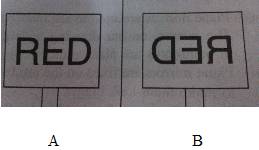
Solution 19
Because while driving our car, if we see in our rear-view mirror that the hospital van is coming from behind, then we will get the laterally inverted image of and read it as AMBULANCE and give way for it to pass through.
Solution 20
A image of our face in a plane mirror is laterally inverted, so left is right and right is left. However, in a photograph of our face this is not the case.
Reflection of Light Exercise 174
Solution 21
(a) A wall has a rough surface, so the reflection by a wall is a diffuse reflection. A parallel beam of light incident on it is reflected in different directions.
A mirror surface is smooth, so the reflection by a mirror is a regular reflection. A parallel beam of light incident on it, gets scattered by making reflected rays in different directions.
(b) Regular reflection
Solution 22
In regular reflection, a parallel beam of incident light is reflected as a parallel beam in one direction; while in diffuse reflection, a parallel beam of incident light is reflected in different directions.
(a) Regular reflection
(b) Regular reflection
(c) Diffuse reflection
(d) Regular reflection
Solution 23
When we see in a completely dark room, we are not able to see anything because there is no light in the dark room.
(a) We can see bulb due to the light emitted by the bulb.
(b) We can see a piece of white paper because it reflects the light from the bulb falling on it.
Solution 24
(a) The image will form 2 m behind the mirror and the width of the image of boy's mouth will be 5 cm.
(b) When the boy walks towards the mirror at a speed of 1 m/s, his image will also appear to move towards the mirror at the same speed of 1 m/s. So, the speed at which his image approach him will be 2 m/s + 2 m/s = 4 m/s.
Solution 25
(a)
(b) Uses of Plane mirrors:
(i) Plane mirrors are used to see ourselves. The mirrors on our dressing table and in bathrooms are plane mirrors.
(ii) Plane mirrors are fitted at blind turns of some busy roads so that drivers can see the vehicles coming from the other side and prevent accidents.
(iii) Plane mirrors are used to make periscopes.
(iv) Plane mirrors are fixed on the inside walls of certain shops to make them look bigger.
Solution 26
The process of sending back the light rays which fall on the surface of an object is called reflection of light.
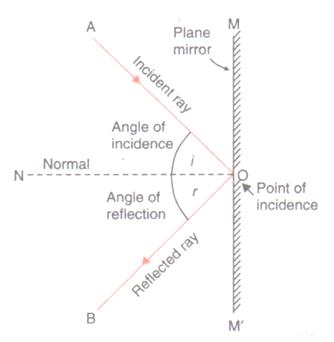
(a) Incident ray: The ray of light that falls on the mirror surface is called the incident ray.
(b) Point of incidence: The point at which the incident ray falls on the mirror is called the point of incidence.
(c) Normal: The normal is a line at right angle to the mirror surface at the point of incidence.
(d) Reflected ray: The ray of light which is sent back by the mirror is called the reflected rays.
(e) Angle of incidence: The angle of incidence is the angle made by the incident ray with the normal at the point of incidence.
(f) Angle of reflection: The angle of reflection is the angle made by the reflected ray with the normal at the point of incidence.
Solution 27
Laws of reflection of light:
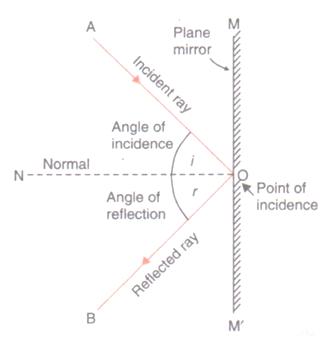
First law of reflection: According to the first law of reflection, the incidence ray, the reflected ray and the normal (at the point of incidence), all lie in the same plane. For e.g., in the figure, the incident ray AO, the reflected ray OB and the normal ON, all lie in the same plane, the plane of paper.
Second law of reflection: According to the second law of reflection, the angle of reflection is always equal to the angle of incidence. For e.g., if we measure the angle of reflection NOB in the figure, we will find that it is exactly equal to the angle of incidence AON.
If the angle of reflection is 47.5o, the angle of incidence will also be 47.5o in accordance with the second law of reflection.
Solution 28
Cosider a point source of light O placed in front of a plane mirror MM'. a ray of light OA coming from O in incident at point A on the mirror and gets reflected in the direction AX according to the laws of reflection of light. Another ray of light OB coming from O strikes the mirror ar point B and gets reflected in the direction BY. Rays AX and BY, on producing backwards, meet at point I behind the mirror; which is the image of point source O.
Characteristics of image formed in a plane mirror:
(i) The image formed in a plane mirror is virtual. It cannot be received on a screen.
(ii) The image formed in a plane mirror is erect. It is the same side up as the object.
(iii) The image in a plane mirror is of the same size as the object.
(iv) The image formed by a plane mirror is at the same distance behind the mirror as the object is in front of the mirror.
(v) The image formed by a plane mirror is laterally inverted.
Solution 29
(a) We can see the image of our face in a plane mirror but not in a sheet of paper because images are formed by regular reflection of light and in case of a plane mirror, regular reflection takes place; while in case of a sheet of paper, diffuse reflection takes place.
(b) The image is virtual and laterally inverted means it cannot be obtained on a screen and is reversed sideways.
(c) A, H, I, M, O
Reflection of Light Exercise 175
Solution 36
Initially, the distance between the man and the mirror is 10m.
So, the distance between man and his image is 10+10=20m
Distance between the man and his image is 5 m when the man is 2.5 m away from the mirror.
Therefore, he has to walk 10 m - 2.5m = 7.5 m towards the mirror.
Solution 37
Initially, the object is placed 20 cm in front of mirror. So the image will form 20 cm behind the mirror.
If mirror is moved 2 cm towards the object,
distance between object and mirror = 20 cm - 2 cm = 18 cm
distance between mirror and image = 18 cm, which is 2 cm less than the initial case.
Since, the mirror has also moved 2 cm away from the position of original image, so the total distance between the positions of the original and final images is 2 cm + 2 cm = 4 cm
Solution 38
Distance between the man and the mirror = 2 cm
Distance between man and chart = 50 cm = 0.5 m
Distance between chart and mirror = 0.5 m + 2 m = 2.5 m
Distance between mirror and the image of the chart = 2.5 m
Distance between man and the image of chart = Distance between man and the mirror + Distance between mirror and the image of the chart = 2 m + 2.5 m = 4.5 m
Solution 39
Ray AB strikes the mirror PQ at B and gets reflected along BC according to the laws of reflection. The ray BC incident on mirror QR makes an angle of 30o with the mirror. So, the angle of incidence on this mirror is 90o-30o=60o. Hence, the angle of reflection is also 60o.
Solution 40
The impression on blotting paper is the mirror image of the written massage. Therefore, to read this message we need to hold the written message in front of a mirror so that the mirror produces a laterally inverted image of this message.
Reflection of Light Exercise 178
Solution 1
(a) Convex mirror (b) Concave mirror
Solution 2
Convex mirror
Solution 3
Radius of curvature (R) = 32cm
Focal length (f) = ?
We know that
f = R/2
=32/2
f = 16cm
Solution 4
Focal length (f) = 25 cm
Radius of curvature (R) = ?
We know that
f = R/2
25=R/2
R= 25 x 2
R = 50 cm
Reflection of Light Exercise 179
Solution 5
(a) principal focus
(b) principle focus
(c) converges; diverges
(d) principle focus
Solution 6
A spherical mirror is that mirror whose reflecting surface is the part of a hollow sphere of glass. The spherical mirrors are of two types: concave mirrors and convex mirrors.
Difference between concave mirror and convex mirror:
A concave mirror is that spherical mirror in which the reflection of light takes place at concave surface (or bent-in surface), whereas a convex mirror is that spherical miror in which the reflection of light takes place at the convex surface (or bulging out surface).
Concave mirror converges the parallel rays of light that fall on it, whereas convex mirror diverges the parallel rays of light that fall on it.
Solution 7
Two types of spherical mirrors are:
(i) Concave mirror
(ii) Convex mirror
Type of mirror represented by the:
(a) back side of a shining steel spoon - convex mirror
(b) front side of a shining steel spoon - concave mirror
Solution 8
For a spherical mirror the principal focus (F) lies exactly mid-way between the pole (P) and centre of curvature (C). So, the focal length (f) of a spherical mirror is equal to half of its radius of curvature (R).
f=R/2
R= 25cm (Given)
f=?
We know that
f=R/2
=25/2
f =12.5cm
Solution 9
All the light rays which are parallel to the principal axis of a concave mirror, converge at the the principal focus (F) after reflection from the mirror. Since a concave mirror converges a parallel beam of light rays, it is also called a converging mirror.
Solution 10
All the light rays which are parallel to the principal axis of a convex mirror, appear to diverge from the principal focus (F) after reflection from the mirror. Since a convex mirror diverges a parallel beam of light rays, it is also called a diverging mirror.
Solution 11
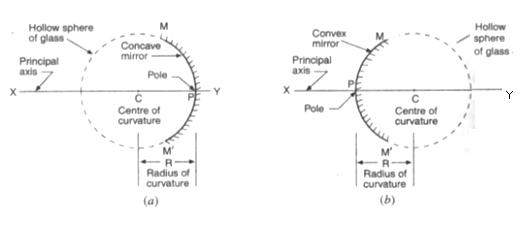
(a) Centre of curvature: Centre of curvature of a spherical mirror is the centre of the hollow sphere of glass of which the mirror is a part.
(b) Radius of curvature: Radius of curvature of a spherical mirror is the radius of the hollow sphere of glass of which the mirror is a part.
(c) Pole: The centre of a spherical mirror is called its pole.
(d) Principal axis: The straight line passing through the centre of curvature and pole of a spherical mirror is called its principal axis.
(e) Aperture: The portion of a mirror from which the reflection of light actually takes place is called the aperture of the mirror.
Solution 12
(a) (i) Principal focus of a concave mirror: The principal focus of a concave mirror is a point on its principal axis to which all the light rays which are parallel and close to the axis, converge after reflection from the concave mirror.
(ii) Focal length of a concave mirror: The focal length of a concave mirror is the distance between its pole and the principal focus.
(b)
Solution 13
(a) (i) Principal focus of a convex mirror: The principal focus of a convex mirror is a point on its principal axis from which a beam of light rays, initially parallel to the axis, appears to diverge after being reflected from the convex mirror.
(ii) Focal length of a concave mirror: The focal length of a convex mirror is the distance from the pole (P) to its principal focus (F).
(b)
Solution 19
Concave metal dish: It will collect the parallel beam of satellite signals at its focus where receiving aerial is fixed.
Solution 20
(a) Concave mirror
(b) A lot of sun's heat rays are concentrated at the point of sun's image which burn the hole in carbon paper.
(c) At the focus
(d) Focal length
(e) A black carbon paper absorbs more heat rays and hence burns a hole more easily (than a white paper).
Reflection of Light Exercise 189
Solution 1
At the centre of curvature
Solution 2
Between pole and focus
Solution 3
Between focus and centre of curvature
Solution 4
At infinity
Solution 5
At focus
Solution 6
Beyond the centre of curvature.
Solution 7
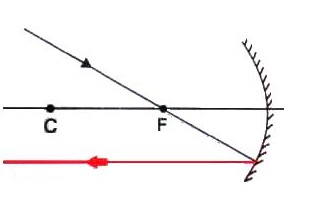
Direction of light fay after reflection.
Solution 8
Solution 9

Fig. formation of image of AC.
Solution 10
Concave mirror
Solution 11
Concave mirror is used in the headlights of a car. This is because when a lighted bulb is placed at the focus of a concave mirror reflector, then the diverging light rays of the bulb are collected by the concave reflector and then reflected to produce a strong, parallel-sided beam of light (which travels a considerable distance in the darkness of night).
Solution 12
A ray of light passing through the centre of curvature of a concave mirror is reflected back along the same path because it strikes the concave mirror at right angles to its surface due to which the angle of incidence and angle of reflection both are oo.
Solution 13
Minimum two rays are required for locating the image formed by a concave mirror for an object.
Ray diagram for the formation of a virtual image by a concave mirror:
Solution 14
Diagram:
When an object is placed at the centre of curvature (C) of a concave mirror, the image formed is:
(i) at the centre of curvature (C),
(ii) real and inverted,
(iii) of same size as the object.
Solution 15
Diagram:
When an object is placed beyond the centre of curvature (C) of a concave mirror, the image is:
(i) between the focus and centre of curvature,
(ii) real and inverted,
(iii) smaller than the object (or diminished).
Solution 16
Diagram:
The focal length of the mirror is PF = 10 cm.
The object is placed at B such that PB = 8 cm. This means that the object lies between the pole and focus of the concave mirror.
The image formed is virtual, erect and magnified.
Solution 17
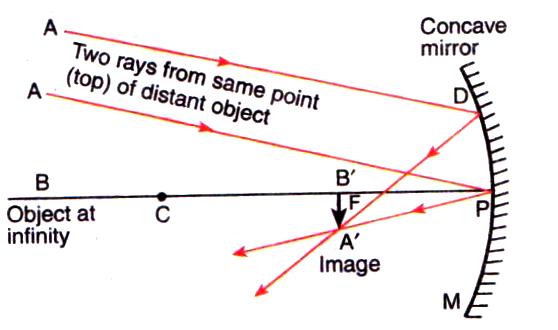
Reflection of Light Exercise 190
Solution 18
Concave mirror is used for a torch reflector.
Diagram:
Bulb is placed at the focus of the torch reflector.
Solution 19
(a) Between pole and focus of the mirror.
(b) At the focus of the mirror.
(c) At the centre of curvature of the mirror.
Solution 20
For obtaining an enlarged upright image of an object, the object is placed between focus (F) and pole (P) of the concave mirror.
A ray AD parallel to the principal axis, gets reflected at D and then passes through the focus F. A second ray AE passing through the centre of curvatue C strikes the mirror normally at point E and gets reflected back along the same path.
Now, two reflected rays DF and EC are diverging rays and, therefore, do not intersect each other on the left side. The reflected rays DF and EC are produced backwards (as shown by dotted lines). On producing backwards, they appear to intersect at point A' behind the concave mirror. Thus, A' is the virtual image of point A of the object. To get the complete image of the object we draw A'B' perpendicular to the axis. Thus, A'B' is the image of the object AB formed by the concave mirror. The image is bigger in size than the object, hence it is an enlarged image.
Solution 21
(a) A real image by a converging mirror
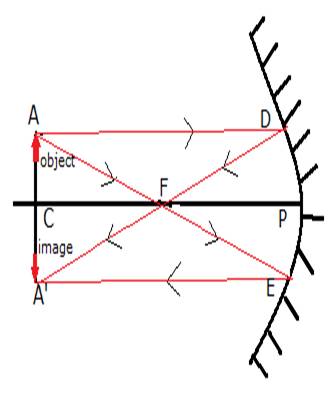
(b) A virtual image by a converging mirror
Solution 22
When the object is at a considerable distance (or at infinity) from a concave mirror, then its image is formed at the focus. This fact can be used to find out the focal length of a concave mirror quickly but approximately.
We focus a distant object (several metres away) like a window or tree on a screen by using a concave mirror whose focal length is to be determined. The sharp image of window or tree will be formed at the focus of the concave mirror. That is, the distance of image (or screen) from the concave mirror will be equal to the focal length of concave mirror. This distance can be measured with a scale. It will give us the approximate focal length of the concave mirror.
Solution 23
Concave mirror is used in a solar furnace.
The solar furnace is placed at the focus of a large concave reflector. When parallel rays of light from the sun fall on the surface of the concave mirror, rays gets reflected and meet at the focus of the mirror due to the converging nature of concave mirror. Thus, the furnace kept at the focus becomes very hot. Even steel can be melted in this furnace.
Solution 24
Concave mirror is used by dentists.
The dentist holds a small concave mirror in such a way that the tooth lies within its focus. A magnified image of the tooth is then seen by the dentist in the concave mirror. Since the tooth looks much bigger, it becomes easy to examine the defect in the tooth.
Solution 25
Concave mirrors are used as shaving mirrors. This is because when the face is placed close to a concave mirror (so that the face is within its focus) the concave mirror produces a magnified and erect image of the face. Since a large image of the face is seen in the concave mirror, it becomes easier to make a smooth shave.
Solution 26
Uses of concave mirror
(i) Concave mirrors are used as shaving mirrors. This is because when the face is placed close to a concave mirror (so that the face is within its focus) the concave mirror produces a magnified and erect image of the face. Since a large image of the face is seen in the concave mirror, it becomes easier to make a smooth shave.
(ii) Concave mirrors are used by dentists to see the large images of the teeth of patients. This is because when a tooth is within the focus of a concave mirror, then an enlarged image of the tooth is seen in the mirror. Due to this, it becomes easier to locate the defect in the tooth.
Solution 27
(a)
(i)
When object is placed between the pole and focus of a concave mirror, the image is formed behind the mirror, it is virtual, erect and larger than the object.
(ii)
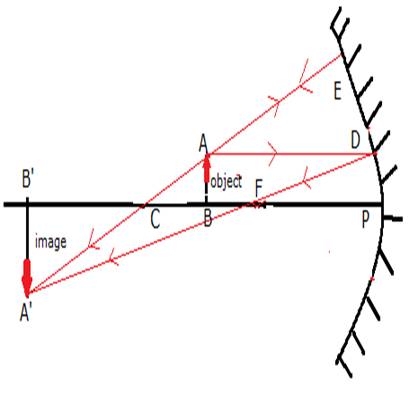
When object is placed between the centre of curvature and focus of a concave mirror, the image is formed beyond the centre of curvature, it is real, inverted and larger than the object.
(b) One use of concave mirror based on the formation of image as in case (i) above: As a shaving mirror.
Solution 28
(a) (i) When the object is placed between the pole and focus of a concave mirror, a magnified image is formed.
(ii) When the object is placed between the focus and the centre of curvature of a concave mirror, a magnified image is formed.
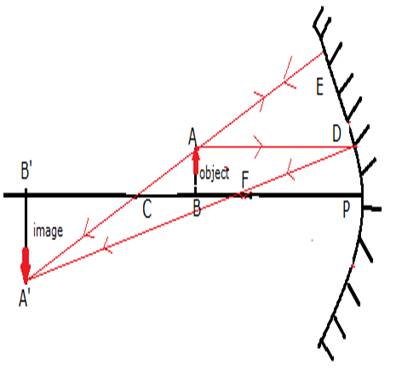
(b) A concave mirror can be used as a shaving mirror when the object is placed between the pole and focus of a concave mirror.
Reflection of Light Exercise 191
Solution 37
Since the image formed is upright, the object lies within the focus of the concave mirror.
So, f > 100 mm
We know R = 2f
So, R > 200 mm
i.e. Radius of curvature is more than 200 mm.
Solution 38
10 cm, because if the object is placed between the pole and focus of the concave mirror only then the image formed is virtual, erect and magnified.
Solution 39
20 cm, because if the object is placed between the pole and focus of the concave mirror only then the image formed is erect and magnified.
Solution 40
(i) A magnified real image - When the object is placed at a distance of 20 cm from the mirror i.e., between focus and centre of curvature.
(ii) A magnified virtual image - When the object is placed at a distance of 10 cm from the mirror i.e., within its focus.
(iii) A diminished real image - When the object is placed at a distance of 35 cm from the mirror i.e. beyond the centre of curvature.
(iv) An image of same size as the object - When the object is placed at a distance of 30 cm from the mirror i.e., at the centre of curvature.
Reflection of Light Exercise 192
Solution 1
(i) Negative
(ii) Positive
Solution 2
(a) Convex mirror
(b) Concave mirror
Solution 3
Convex mirror (since focal length is positive).
Solution 4
Concave mirror (since focal length is negative).
Solution 5
Pole
Solution 6
(a) Negative
(b) Positive
Solution 7
According to the New Cartesian Sign Convention:
(i) All the distances are measured from pole of the mirror as origin.
(ii) Distances measured in the same direction as that of incident light are taken as positive.
(iii) Distances measured against the direction of incident light are taken as negative.
(iv) Distances measured upward and perpendicular to the principal axis are taken as positive.
(v) Distance measured downward and perpendicular to the principal axis are taken as negative.
Reflection of Light Exercise 193
Solution 8
(a) Object distance (u) for a concave mirror or convex mirror is always negative because an object is always placed to the left side of the mirror and the distances towards the left of the mirror are always negative.
(b) In case of a concave mirror, if the image is formed on the left side of the mirror, then the image distance (v) will be negative and if the image is formed on the right side of the mirror, then the image distance (v) will be positive. This is because distances measured to the left of the mirror are negative and to the right of the mirror is positive.
(c) Image distances (v) for a convex mirror is always positive because the image is always formed behind the mirror.
Reflection of Light Exercise 198
Solution 1
Solution 2
Object distance, u = -20 cm
Focal length, f = -20 cm (concave mirror)
Image distance, v =?
We know that
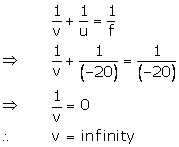
Solution 3
(a) If m = + 4, then the image is virtual and erect.
(b) If m = - 2, then the image is real and inverted.
Solution 4
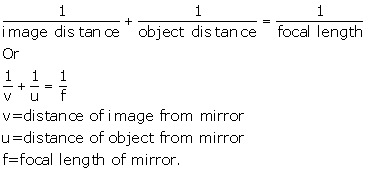
Solution 5
Mirror formula is given below
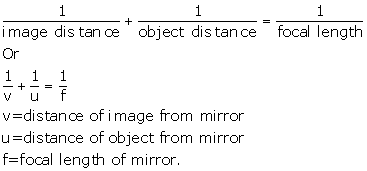
Solution 6
The ratio of height of an image to the height of an object is known as magnification.
Solution 7
The ratio of the height of image to the height of object is known as linear magnification.
Solution 8
(a) Magnification![]()
(b) Magnification![]()
where, h2= height of image
h1= height of object
v= image distance
u= object distance
Solution 9
Here, u = - 20 cm ; f = -10 cm
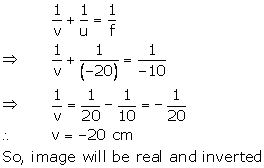
Solution 10
(a) virtual; erect
(b) real; inverted
Solution 11
(a)
(b) f=-20cm, u=-10cm, v=?
We know that
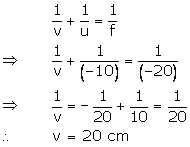
(c) Characteristics of image formed
(i) Image is virtual.
(ii) Image is erect.
Solution 12
h1=10cm, u=-36cm, f=-12cm
We know that
Solution 13
f=-10cm, h1=2cm, h2=6cm (erect image)
u =?
We know that:
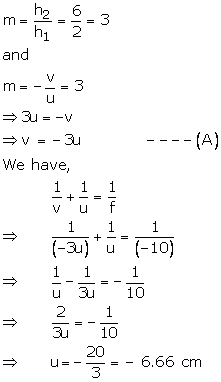
The object should be placed at a distance of 6.66 cm on the left side of the mirror.
Solution 14
u=-15cm, v=-10cm
f=?
We know that
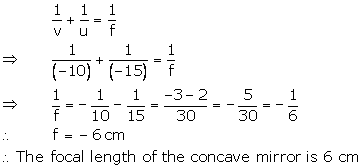
Solution 15
h1=3cm, u=-8cm, h2=4.5 (virtual image)
Solution 16
Solution 17
Reflection of Light Exercise 199
Solution 18
Solution 19
h1=2cm, u=-9cm, f=-4cm
We know that
Solution 20
Given:-
u =-20cm, m=- 3 , for the real image
Solution 21
Solution 22
Solution 23
h1=5.0cm, u=-20cm, f=-15cm, v=?, h2=?
We know that

The screen should be placed 60 cm in front of the mirror.
And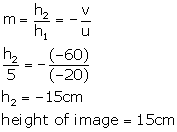
Solution 24
m=3 (virtual image)
u=-10cm
R=?
We know that
Solution 25
h1=50mm, f=-100mm, u=-300mm, h1=?
We have:
Solution 26
f=-20cm, m=-1/4 (real image)
We know that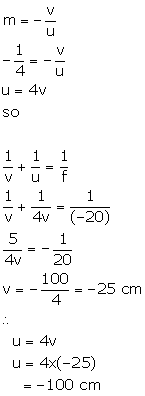
The object should be placed 100 cm to the left of the mirror.
Solution 27
Solution 28
Solution 29
h2=1cm=10mm (real image), h1=2.5mm, u=-5cm=-50mm
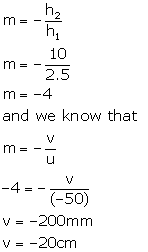
The image is formed 20 cm in front of the mirror.
And,
Solution 30
Radius of curvature, R=-60cm (concave mirror)
f=-30cm, u=-15cm
We have
So, the the image is formed 30 cm behind the mirror and the magnification is +2.
Solution 31
(a)
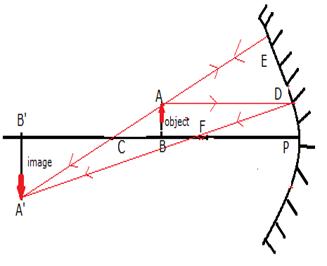
The image is real, inverted and magnified. It is formed beyond the centre of curvature of the mirror.
(b) If the object is moved further away from the mirror, the image is formed nearer to the mirror and its size goes on decreasing.
(c) u=-24cm
v=-16cm
f=?, R=?, m=?
we know that
Reflection of Light Exercise 200
Solution 42
(a) Between focus and centre of curvature.
(b) Between pole and focus.
(c) Beyond the centre of curvature
Solution 43
Solution 44
Solution 45
Reflection of Light Exercise 205
Solution 1
(a) Virtual and erect
(b) Virtual and erect; real and inverted
Solution 2
Convex mirror has a wider field of view.
Solution 3
Concave mirror
Solution 4
Convex mirror always produces a virtual, erect and diminished image.
Solution 5
Image is formed at the focus.
focus = 30/2 = 15 cm
i.e. 15 cm behind the convex mirror.
Solution 6
Concave mirror
Solution 7
Convex mirror
Solution 8
Concave mirror should be used to get a magnified image.
Solution 9
(a) Concave mirror
(b) Convex mirror
Solution 10
True
Solution 11
(a) Concave mirror
(b) Convex mirror
Solution 12
Convex mirror
Solution 13
Solution 14
Solution 15
focus
Solution 16
A driver prefers to use a convex mirror as a rear-view mirror because
(i) A convex mirror always produces an erect image of the objects.
(ii) A convex mirror has wider field of view.
Solution 17
We cannot use a concave mirror as a rear-view mirror in vehicles because a concave mirror produces inverted images of distant objects. So, all the vehicles will be seen running upside down in the mirror.
Solution 18
(a) Image will form between pole and focus
(b) At focus
Reflection of Light Exercise 206
Solution 19
(a) R=50cm
f=?
We know that
f=R/2 = 50/2 = 25 cm
(b) Convex mirror
(c) It will diverge light rays.
Solution 20
The advantage of using a convex mirror as a rear-view mirror in vehicles as compared to a plane mirror is that a convex mirror has a wider field of view as compared to a plane mirror. This enables driver to view much larger area of the traffic behind him.

Solution 21
Two uses of convex mirror:
(i) A convex mirror is used as a rear-view mirror in vehicles because it forms erect and dimished images of the objects and has a wider field of view.
(ii) Big convex mirrors are used as security mirror in shops so that a large number of goods displayed in the shop can be seen in the convex mirror.
Solution 22
(a) Our image will be diminished, virtual and erect. This is because when the object lies anywhere between the pole and inifinity, the concave mirror forms a diminished, virtual and erect image.
(b) Our image will be enlarged, virtual and erect. This is because when the object lies within the focus of a concave mirror, it forms an enlarged, virtual and erect image.
Solution 23
Shaving mirror - concave mirror
Car headlight mirror - concave mirror
Searchlight mirror - concave mirror
Driving mirror - convex mirror
Dentist's inspection mirror - concave mirror
Torch mirror - concave mirror
Staircase mirror in a double-decker bus - convex mirror
Make-up mirror - concave mirror
Solar furnace mirror - concave mirror
Satellite TV dish - concave mirror
Shop security mirror - convex mirror
Solution 24
We can distinguish between a plane mirror, a concave mirror and a convex mirror by bringing our face close to each mirror, turn by turn. If the image is of the same size as our face, it is a plane mirror. If the image is magnified, it is a concave mirror. If the image is diminished, it is a convex mirror.
Solution 25
The images formed in the convex rear-view mirror will be smaller than those formed in the plane rear-view mirror.
Solution 26
(a)
(b) When the object is moved away from the mirror, then the size of the image goes on decreasing.
(c) Image formed by a convex mirror is virtual, erect and diminished.
Solution 27
(a) fig 51
(b) The image formed is virtual, erect and highly diminished.
(c)
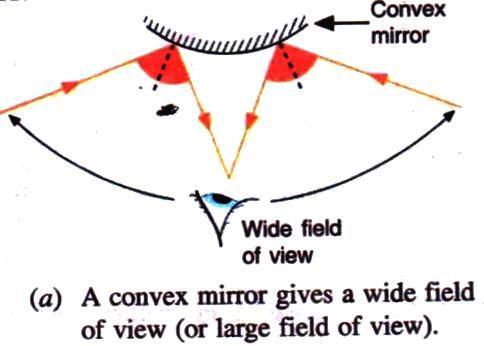
Reflection of Light Exercise 207
Solution 37
(a) Mirror B is convex since it forms a smaller image of fork.
(b) Mirror A is concave since it forms a larger image of fork.
Solution 38
(a) The purpose of the dish is to collect a large amount of TV signals from the satellite.
(b) Concave.
(c) At the focus of the dish.
(d) Stronger signals will be received.
Solution 39
(a) Convex - Because a convex mirror forms a diminished image when the object is placed near it.
(b) Concave - Because a concave mirror forms an enlarged image when the object is placed near it.
(c) Plane - Because a plane mirror forms an image of same size as the object.
Solution 40
(c) Mirror A is concave and mirror B is plane.
Reflection of Light Exercise 209
Solution 1
u=-5cm, f=10cm
We know that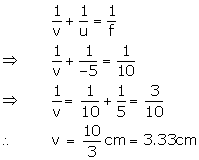
The position of the image is 3.33 cm behind the convex mirror.
Magnification, m= -v/u = -3.33/-5 = 0.66
The image is virtual and erect.
Solution 2
(i)
(ii) The image formed is diminished and erect.
(iii) u=-10cm, f=5cm
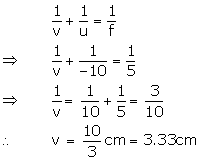
Solution 3
u=-6cm, f=12cm, v=?
We know that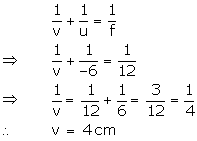
Image will be formed 4 cm behind the mirror.
Since the image is formed behind the convex mirror, it is virtual and erect.
Solution 4
(a) u=-20cm, v=-15cm
We know that
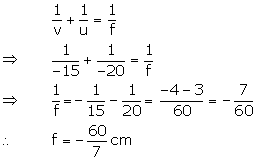
The mirror is a concave mirror.
(b) u=-20cm, v=15cm
We know that
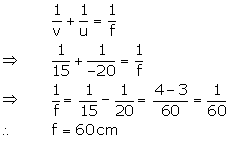
The mirror is a convex mirror.
Solution 5
h1=2.5cm, u=-25cm, f=20cm
We know that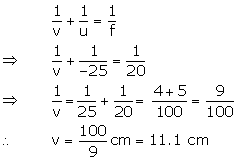
The image is formed 11.1 cm behind the convex mirror.
Now,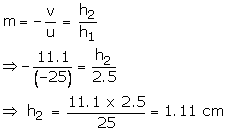
The image is virtual, erect and 1.11 cm tall.
Solution 6
R=3m, u=-5m,
We know that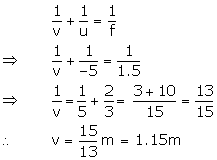
The image is formed 1.15 m behind the mirror.
The image is virtual and erect.
Solution 7
R=40cm
f=R/2=40/2=20cm
Image is half the height of the object.
So, the object is placed 20 cm in front of the mirror and the image is formed 10 cm behind the mirror.
Solution 8
Solution 9
(a)
(b) h1=1cm, u=-30cm, f=20cm, h2=?, v=?
Solution 10
(a) The mirror is of convex type.
(b)u=-5cm, m=1/10
We have
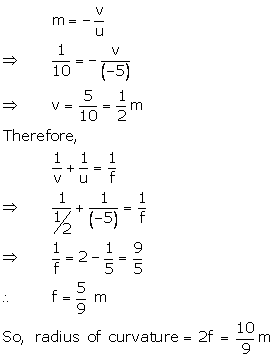
Reflection of Light Exercise 210
Solution 11
(a) u=-15cm,
R=-20cm (Converging mirror)
f = R/2 = -10 cm
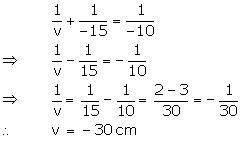
The image is formed 30 cm in front of the mirror.
![]()
R=20cm (Diverging mirror)
f = R/2 = 10 cm

The image is formed 6 cm behind the mirror.
![]()
Solution 12
u=-20cm
v=15cm (virtual image)
We know that![]()
The mirror used is of convex type.

